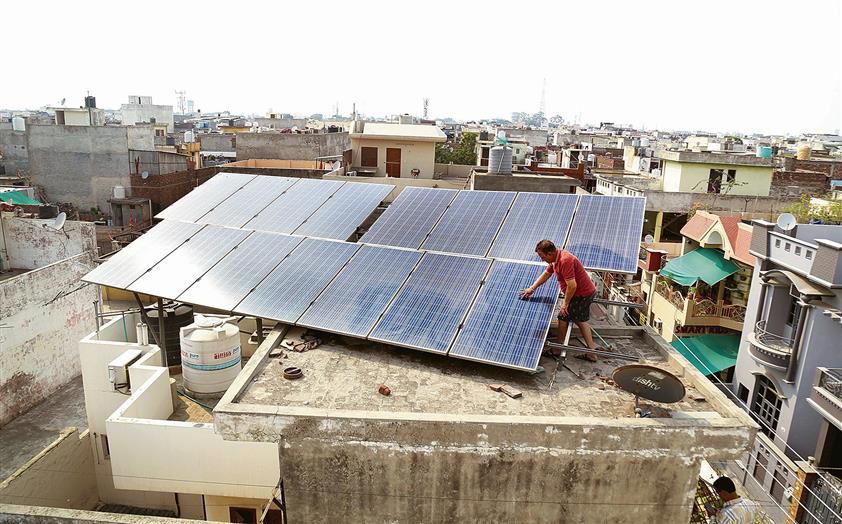Few takers for solar power in Punjab as free electricity flows
Ruchika M Khanna and Balwant Garg
Tribune News Service
Chandigarh, June 24
While the world makes giant strides towards shifting to renewable energy sources, populist decisions taken by the Punjab Government to give free power to agriculture sector and 300 units of free power to domestic consumers have led to a fall in number of domestic consumers going in for solar power generation on their rooftops.
Domestic consumers unwilling to invest Rs 1.5 lakh-Rs 2 lakh for rooftop solar system installation
There are also no takers for the solar power generation for running the agriculture pumpsets since power to the farm sector is also free. Nearly 24 per cent of the total power generated is consumed by 14 lakh agriculture pumpset consumers and they use power during the day, which are the peak load hours.
Gujarat on top in green energy
As per information, given by former Union Minister for New & Renewable Energy and Power RK Singh, in written replies to two separate questions in Lok Sabha on December 21, 2023, Gujarat has highest 3174.04 MW cumulative RTS, followed by 1852.22 MW in Maharashtra, 1067.25 MW in Rajasthan, 591.17 MW in Kerala, 518.49 MW in Haryana, 497.37 MW in Karnataka, 489.32 MW in Tamil Nadu, 367.18 MW in Telangana, 316.51MW in Madhya Pradesh and 396.84 MW RTS power generation capacity in Punjab, which includes 159.10 MW domestic and 237.74 MW on commercial buildings.
How do RoofTop Solar plants work
- The grid connected rooftop solar (RTS) photovoltaic power generation plants generate electricity at the consumer point and hence contributes to reducing the network losses of the distribution. It also contributes to meeting the demand and supply gap
- RTS generates power during the daytime and feeds excess power to the grid. This system does not require battery back-up as the grid acts as the back-up for feeding excess solar power and vice-versa
When was net metering introduced
- To promote the RTS plants, the state government had notified the Net Metering Policy in August 2014, offering all consumers to install the RTS on the rooftops up to 80 per cent of their sanctioned loan
- In this on-grid system, it uses the existing service lines for injection and drawl of power from the grid. It is accounted for through bi-directional meters, installed by PSPCL. The RTS is known as a clean and climate-friendly energy
Consumers not getting subsidy
- Consumers are not getting the subsidy, which has a ripple effect. Residential consumers installing grid-connected RTS avail the Central Financial Assistance (CFA)
- Under the CFA, Rs 14,588 per kW for first 3 kW RTS capacity and Rs 7,294/kW for RTS capacity beyond 3 kW and up to 10 kW is provided in Punjab
- However, Rajinder Kumar of Tagore Nagar, Jalandhar, says that he and almost all other consumers, have been waiting for the subsidy to be released for 10 months of 2019
With domestic consumers getting 300 units of free power every month, or 600 units in a billing cycle, they are unwilling to make an investment of Rs 1.5-Rs 2 lakh for installing the on grid rooftop solar (RTS) system, ever since the free power to domestic consumers was started in July 2022.
Data available with The Tribune shows that the number of domestic consumers opting for the RTS grew by 14,978 between 2019 and 2022 (when the free power scheme began). The generation capacity then was 107.31 MW. Between March 2022-2024, only 7,508 consumers opted for solar power and the generation capacity reached 159.10 MW.
“Now, only those consumers, whose consumption is more than 300 units per month, are installing RTS systems,” confirmed a top official in the Punjab State Power Corporation Limited (PSPCL).
Parminder Singh, a proprietor of solar system integration company in Jalandhar, told The Tribune that in the past two years, there is nearly a 40 per cent drop in the number of people opting for solar power. “Though the price of RTS systems have decreased since 2019 onwards, the small domestic power consumers have bifurcated their meters to remain in the bracket of small consumers and avail free power benefit, rather than investing in the solar power,” he said.
Officials in the Punjab Energy Development Authority (PEDA) told The Tribune that since the domestic consumers started shying away from RTS systems, they have been concentrating on getting these installed in the government buildings. “Till 2022, the generation capacity through RTS on government buildings was 26878.9 kW, which has now gone up to 33155.9 kW, an increase of 6277 kW,” said a senior officer.
In Faridkot, there is a huge decline in the new RTS installations after July 2022. Starting from 2019, the number of new RTS plant installations in Faridkot subdivision was 125 in 2019, 230 in 2020 and 303 in 2021. But the total number of new domestic RTS installations in Faridkot subdivision had fallen to 74 in 2022, 20 in 2023 and 25 RTS in 2024.
After the PSPCL implemented the scheme of 600 free units to every household per billing cycle (2 months), a large number of consumers in Faridkot started getting new power connections increasing it from one connection to two or more connections in a joint family house or building to show a separate household and get the benefit of 600 units scheme on every connection.
The year-wise new domestic power connections in Faridkot subdivision showed that there was about 60 per cent increase in new domestic connections in just five months of 2022 after the introduction of the 600 units free scheme. “They would rather avail free power than invest in RTS systems,” said Mange Ram, a domestic consumer in Nihalsinghwala.
In Amritsar, too, the number of those opting for solar power has come down since the free power was introduced. There were 944 RTS projects here till July 2022, but since the introduction of the scheme, only 264 have been added.









